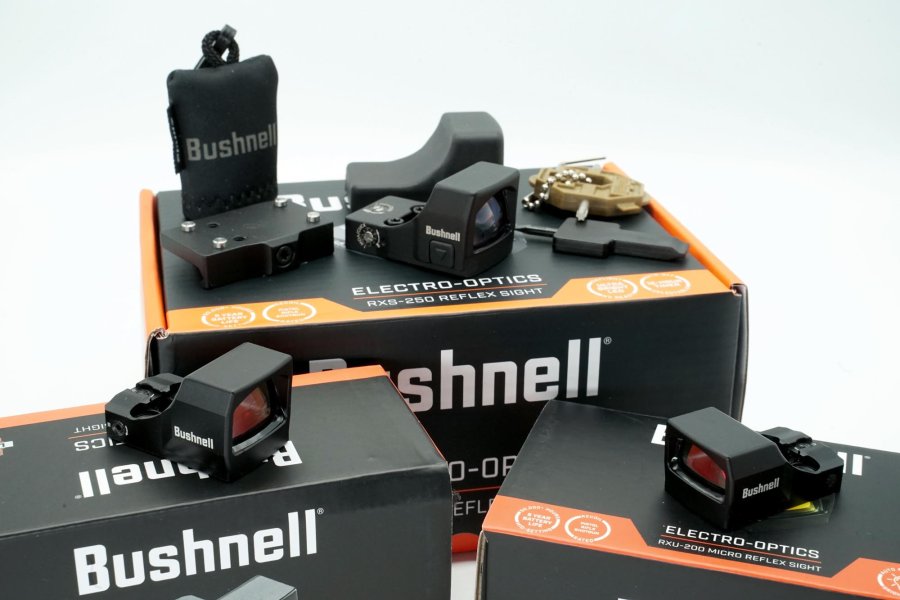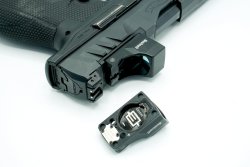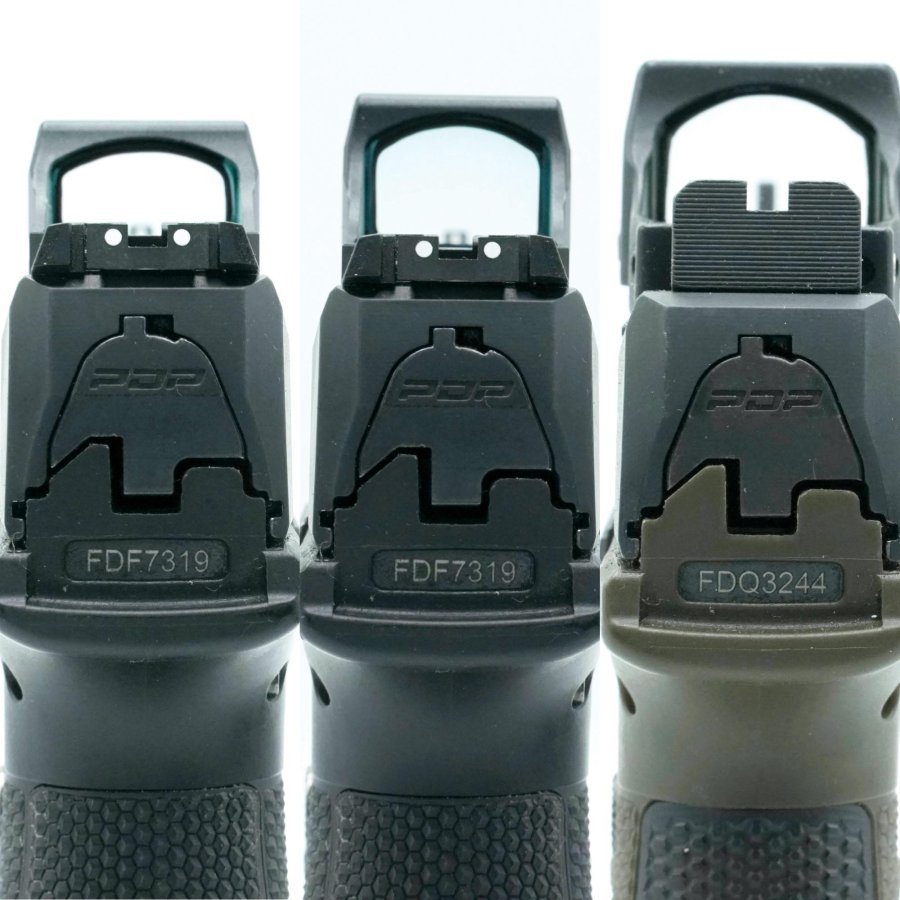With the increasing popularity of slide-mounted red dot sights, the range is also growing steadily and covers a wide price range. Unfortunately, however, the top models still have one thing in common – a high price. Sometimes this can come close to or even exceed the purchase price of the gun, which scares off many prospective buyers or makes them look for cheaper alternatives. Unfortunately, the saying "Buy cheap, buy twice" often proves to be true. This is because cheaper sights either disappoint due to poor quality such as aberrations, strong lens tinting, fuzzy dots, imprecise reticle adjustment or are simply unreliable and fail after a few hundred shots. Changing this is Bushnell's declared aim with the three new red dot sights RXS-250, RXC-200 and RXU-200, which are intended to close the gap between the quality requirements of high-quality, durable optics and a still acceptable price. Has Bushnell really succeeded in squaring the circle with its trio of optics?
The largest red dot in comparison: Bushnell RXS-250 in detail

The largest red dot sight in our trio can also be mounted on long guns and is supplied with a suitable Picatinny mount for this purpose. There are also plenty of other accessories included in the scope of delivery: a form fit protective cover, mounting and adjustment tools, mounting screws (M4 T15 Torx) and a microfiber cleaning cloth. Thankfully, it was decided to use the same footprint as the Leupold DeltaPoint Pro, which opens up countless other mounting options on pistols. Made from 7075-T6 aluminum, the housing of the RXS-250 is not only waterproof and dustproof in accordance with IP67 protection class, but is also drop and impact tested in accordance with the U.S. MIL-STD-810H standards. In terms of dimensions, it corresponds to the Trijicon RMR (see table below). The model has a distinctive silhouette thanks to its striking chamfered and filleted hood that surrounds the lens. True to the motto "form follows function", this design also fulfills a purpose. The hood geometry, in conjunction with the backwards tilted lens, ensures maximum protection. The lens features a True Tone color multi-coating, which ensures neutral color representation and high light transmission (86%). The RXS-250 is only available with a 4-MOA dot. A CR2032 3V button cell is used for the power supply and, fortunately, the largest of the three red dot sights is designed as a top-loader. The battery compartment is therefore located on the top of the housing so that the sight do not have to be laboriously removed for a battery change. The RXS-250 has a total of 10 brightness settings, which can be selected using the two rubberised buttons located on the sight housing. The button located on the left in the direction of firing can be used to increase the brightness and the button on the right dims the dot. Both buttons are clearly labelled with corresponding up and down arrow symbols. According to the manufacturer, the battery life is 50,000 hours on brightness setting 5. To switch the sight on, simply press one of the two buttons briefly. To switch the sight off again, the button with the down arrow symbol (on the right-hand side of the housing) must be held down for three seconds. To save battery life, the sight also has an automatic power-down function that switches off the optic after twelve hours. If you do not need this function, you can deactivate it by pressing and holding both buttons for three seconds. The lowest brightness setting can be used with night vision devices. The adjustment screws for the aiming point are located in the upper rear or right-hand housing area and both have a click adjustment. Each click adjusts the point of impact by 1 MOA, whereby a narrow slotted screwdriver is always required for any corrections. Neat laser engravings indicate the direction and range of adjustment.

For compact and sub-compact pistols: Bushnell RXC-200 Compact & RXU-200 Ultra Compact red dot sights

In contrast to the RX-250, these models are designed for use on compact or sub-compact pistols such as the GLOCK G43, S&W Shield, SIG P365 or Springfield Armory Hellcat. The difference between the two RXU 200 variants is the lens height: Compact 23.5/15 mm, Ultra Compact 19.5/11 mm. Like the larger model, they have a rugged aluminum housing and, at 23 to 25 grams, prove to be true flyweights. All this has hardly any effect on the weight of the firearm, which of course favors their primary use on EDC guns. They have a Shield RMSc footprint, so be careful when ordering the right optics adapter plate. The very low housing height conveniently eliminates the need for higher mechanical sights as back-ups. Instead, co-witnessing with the factory sights can be achieved. However, this ultra-compact design is unfortunately not entirely free of disadvantages. First and foremost, the RXC-200 and RXU-200 have no manual brightness setting. Instead, this is controlled automatically by the built-in photocell. In principle, this did not give rise to any criticism during our practical test. Nevertheless, we prefer manual adjustment, as you are more flexible and can better adapt the dot to your own needs. To change the CR2032 button cell, both models have to be removed from the gun, which not least involves a time-consuming check of the point of aim. Finally, the compact models have no click adjustment for correcting the point of impact.
Field testing the red dots: with the Bushnell models RXS-250, RXC-200 and RXU-200 on the shooting range
We limited ourselves to mounting the two most different models of the trio in the form of the XS-250 and RXU-200 Ultra Compact on a Walther PDP 4.6" SD Pro and a 4.5" PDP Fullsize for practical testing with suitable adapter plates. The M4 mounting screws were tightened to a torque of 15 lbf in (1.6 Nm) according to the operating instructions. At the beginning, both red dot sights were shot at 10 meters before we got down to business. For several weeks, the pair accompanied us regularly to the shooting range, where, in addition to standard exercises such as dot drills in all possible variations, different IPSC stages were also completed. As expected, the larger lens of the RXS-250 favored the peripheral observation of the dot during shooting, whereas the significantly smaller lens of the RXU-200 Ultra Compact required a very determined grip. In addition, the smaller lens instantly penalises any uncleanliness when moving to the firing position. After just over 2,000 shots, both Bushnell red dot sights made a more than respectable impression on us. Of course, after this manageable load, it is difficult to make a statement about the performance of the optics. However, this number of shots simply does not represent a continuous load.

But allow us to make an initial judgement on the practicality of the optics: First and foremost, the two optics performed flawlessly. Neither point of impact misalignments nor other electronic or mechanical failures were recorded. In addition, both sights impressed with clean reticles and a distortion-free image. And even with the automatically controlled illumination of the 6 MOA dot of the smaller model, it was possible to work equally well both in daylight and under artificial light. In both cases, the automatic system reacted reliably to different lighting conditions and adjusted the light intensity accordingly.
Bushnell RXS-250, RXC-200 Compact, RXU-200 Ultra Compact specs and prices
| Model: | Bushnell RXU-200 Ultra Compact | Bushnell RXC-200 Compact | Bushnell RXS-250 |
Housing Material: | Aluminum | Aluminum | Aluminum |
Lens Size: (HxW): | 11x21 mm | 15x21 mm | 17x24 mm |
Overall Dimensions (LxWxH): | 42.4x24.6x19.5 mm | 42.4x24.6x23.5 mm | 45.7x30.8x27.1 mm |
Weight (w/ Battery): | 23 g | 25 g | 39.6 g |
Dot Size: | 6 MOA | 6 MOA | 4 MOA |
Brightness Adjustment: | Auto-ambient brightness adjustment | Auto-ambient brightness adjustment | 10 brightness settings, manual brightness control, auto power-off option |
Battery: | 1x 3Volt CR2032, 50,000 h runtime | 1x 3Volt CR2032, 50,000 h runtime | 1x 3Volt CR2032, 50,000 h runtime at medium light intensity |
Scope of delivery: | CR2032 battery, mounting screws (M3), Torx right angle key, adjustment tool, microfiber cleaning cloth, operating manual | CR2032 battery, mounting screws (M3), Torx right angle key, adjustment tool, microfiber cleaning cloth, operating manual | Picatinny mount, CR2032 battery, mounting screws (M4), Torx right angle key, adjustment tool, microfiber cleaning cloth, operating manual |
Height/side adjustment: | Stepless | Stepless | Click adjustment (1 MOA) |
Footprint: | SHIELD RMSc | SHIELD RMSc | Leupold Delta Point Pro |
Price (MSRP): | 279,95 euro | 279,95 euro | 349,95 euro |
Our test results for the Bushnell RXS-250, RXC-200 and RXU-200 red dot sights
Thanks to the large viewing window, the manual brightness adjustment, the finer 4-MOA red dot and the "toploader" function, the RXS-250 is, in our opinion, an interesting alternative for the sporting sector. However, we see the more compact versions RXC-200 Compact and RXU-200 Ultra Compact more as a solution for concealed carry guns, not least due to the extremely low silhouette in conjunction with the more stress-resistant, automatic brightness adjustment. Prices are €349.95 for the RXS-250 and €279.95 for the compact models.
Further information on the RXS-250, RXC-200 and RXU-200 red dots can be found on the Bushnell website.



